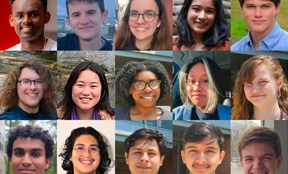
TREND 2024 end-of-summer conference poster gallery and booklet.

Project type: Computation and Experiments
The study of the nonlinear dynamics in charged particle beams at the extreme frontier of intensity is important for many applications. Example applications include high-energy and nuclear physics, material science (using spallation neutron sources and x-ray free electron lasers and related intense light sources), free electron lasers for directed energy, and future heavy ion-driven inertial fusion concepts. At high intensity, particles experience internal forces from other particles (space charge) that are comparable to the applied external focusing and accelerating forces. The internal space charge forces depend on the constantly-evolving beam distribution and are typically nonlinear. The group operates a world-class experimental research facility: the University of Maryland Electron Ring (UMER), a compact accelerator using low-energy, high-current electron beams to model the dynamics of intense beams.
Projects suitable for undergraduate participation will be centered on relevant scientific issues. Examples are:
Prof. Beaudoin is also a lead researcher in the CMFX (Centrifugal Mirror Fusion eXperiment), giving participants access to projects at the cutting edge of plasma fusion.
The Charged Particle Beam Group has mentored over thirty undergraduate research assistants in recent years, many of whom have appeared as co-authors on scientific publications. Examples include Ksenia Danylevich, Matt Holland, Brian Beaudoin, Matthew Bakalar, Erin Sohr, Nader Behdin, Nana Asare, and Kiersten Ruisard.
Want help getting in touch with this mentor? Reach out to Daniel.